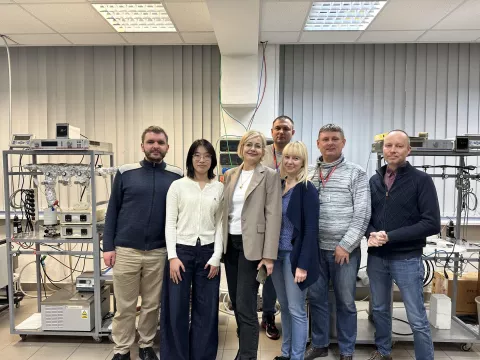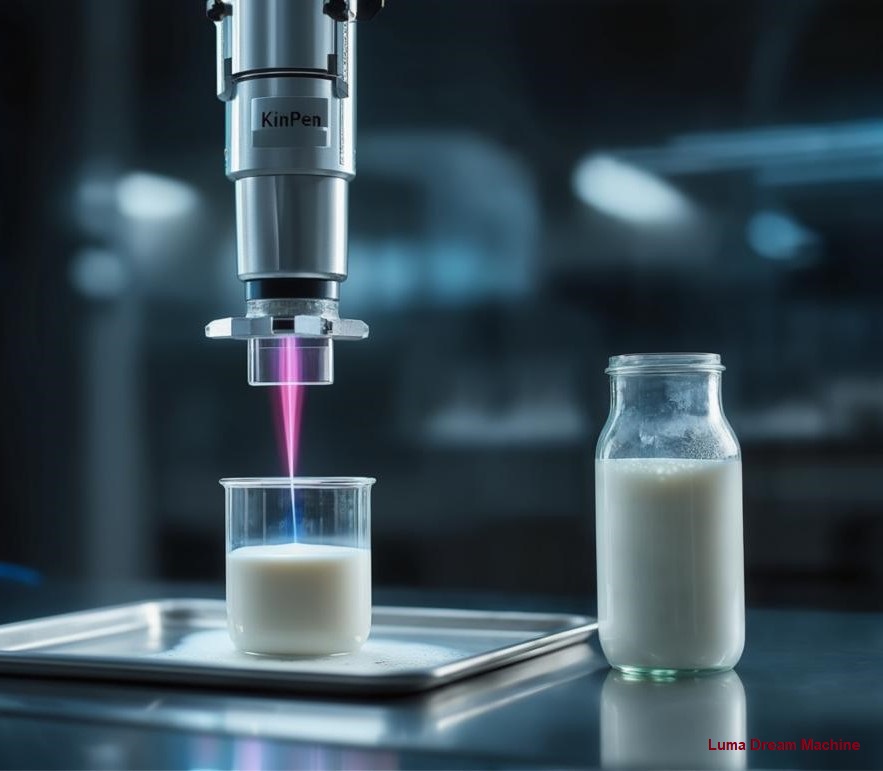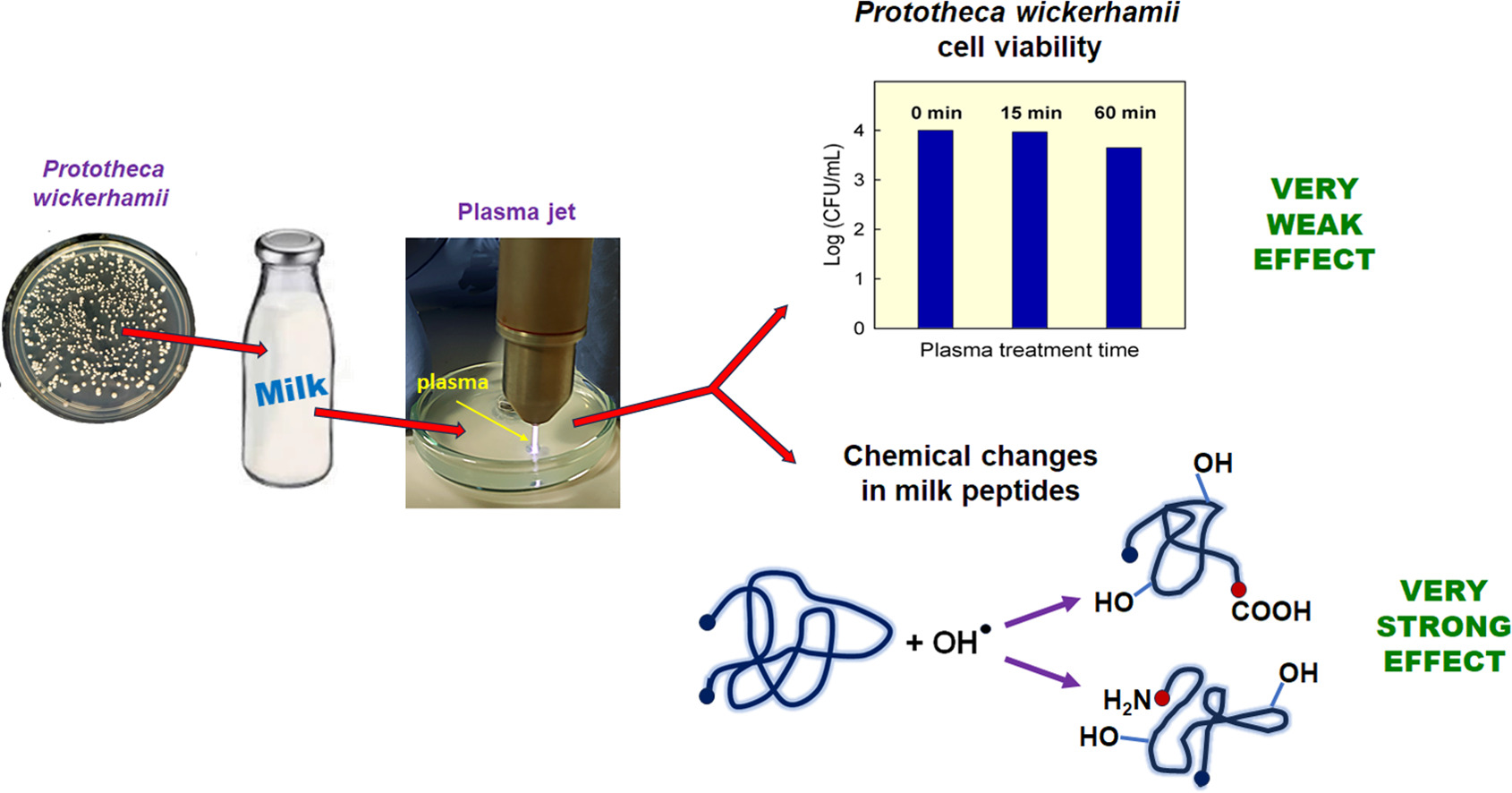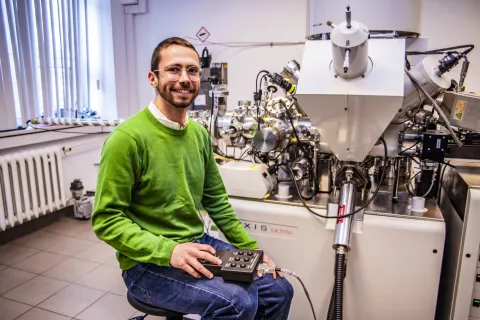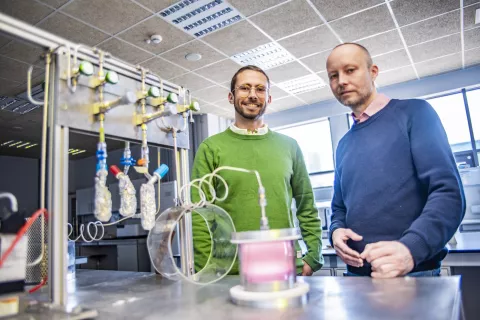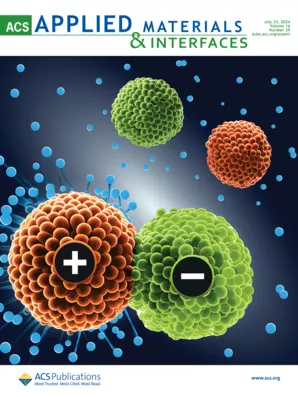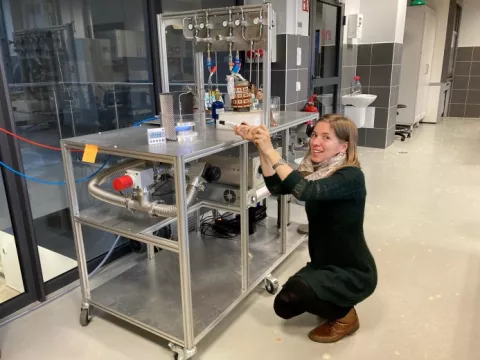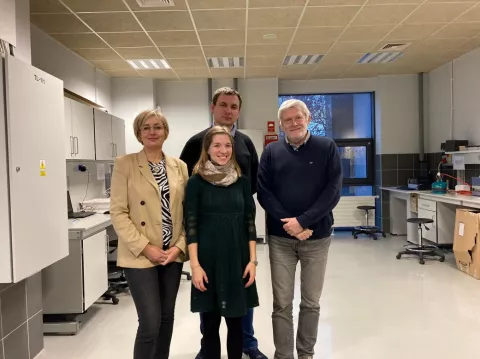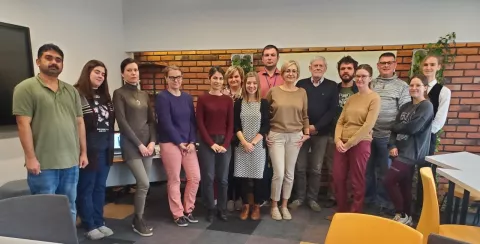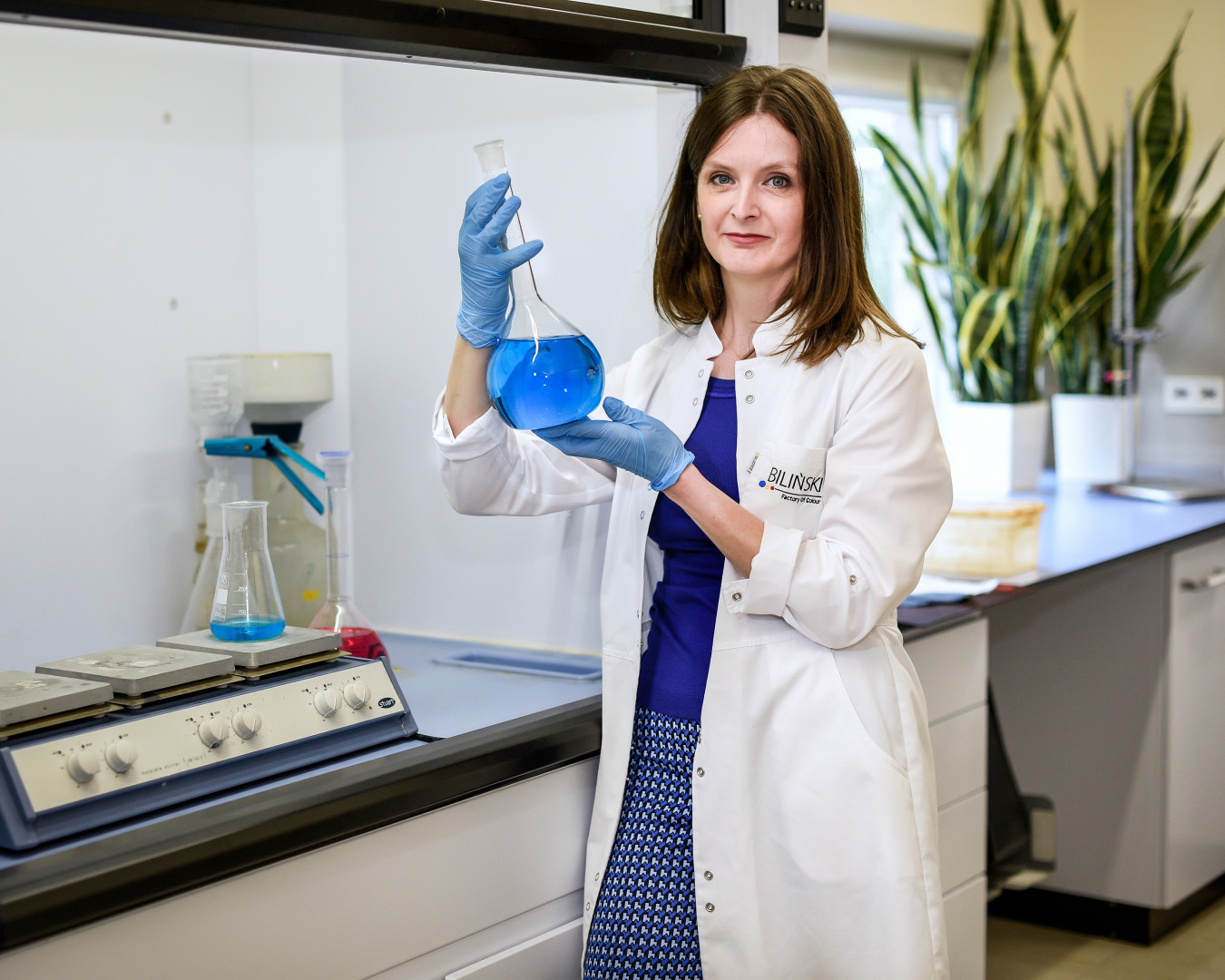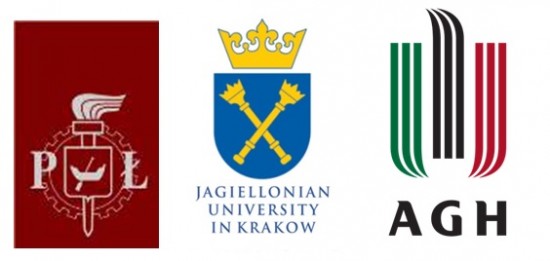Poland–China collaboration: Plasma-prepared catalysts for CCUS technologies
From November 12 to 25, 2025, we hosted Liju Bai from the School of Chemistry and Chemical Engineering, Beijing Institute of Technology (China). The visit was funded under the PROM project (FERS.01.05-IP.08-0218/23).
Liju Bai is pursuing a Ph.D. entitled “Design and Process Research for High-Performance Carbon Capture Materials” under the supervision of Prof. Helei Liu. Research in this area, conducted at the Department of Molecular Engineering under the guidance of Prof. Hanna Kierzkowska-Pawlak, focuses on designing innovative thin-film catalysts for CO₂ capture and conversion. During the internship, under the supervision of Dr. Ryszard Kapica, Liju Bai fabricated nanostructured catalysts using the PECVD method, which will be applied to intensify CO₂ capture processes. The efficiency of these catalysts and their impact on the performance of CO₂ removal processes will be tested in laboratory-scale CO₂ capture installations in China.
2025-11-26
Revealing the limits of cold plasma in dairy decontamination
Top-ranked Food Chemistry publishes our research on plasma inactivation limits in milk
Our team from the Division of Molecular Engineering (prof. J. Tyczkowski and dr R. Kapica), in collaboration with the Medical University of Lodz and the Centre of Molecular and Macromolecular Studies (Polish Academy of Sciences), has published a new study in Food Chemistry (Vol. 480, 2025). The research reveals that protein fractions in cow milk significantly reduce the effectiveness of cold atmospheric plasma in inactivating Prototheca algae by scavenging OH radicals. These results highlight important limitations for plasma-based decontamination in dairy processing and have broader implications for plasma applications in food and medicine.
2025-05-19
Gabriel Marques, a second-year PhD student in Physics Engineering at the University of Aveiro, is visiting the Division of Molecular Engineering at Lodz University of Technology as part of the PROM program.
Gabriel Marques, a second-year PhD student in Physics Engineering from the University of Aveiro is spending three weeks (24.02.2025-15.03.2025) at the Division of Molecular Engineering at Lodz University of Technology as part of the PROM program.
Gabriel's research focuses on the functionalization of silica nanoparticles with organic dyes and their optical characterization. His objective is to optimize the functionalization process to achieve controllable optical properties, which can be applied in sensors for leak detection. During his stay, under the supervision of Dr. Jacek Balcerzak, he is utilizing X-ray Photoelectron Spectroscopy (XPS) to gain crucial insights into the surface chemical structure of nanoparticles and to correlate these findings with their optical properties.
Autor: Marcin Szmidt
Our team proposes a novel approach to the “alchemy” of catalysts
What's the deal with synergy? The role of heterojunctions in nanohybrid catalysts for thermal catalysis
Solid catalysts, often nanoscale materials, are at the heart of many technologies. In the recent Perspective „Classical Concept of Semiconductor Heterojunctions in the Approach to Nanohybrid Catalysts” (J. Tyczkowski & H. Kierzkowska-Pawlak) we explored the secrets of nanohybrid catalysts— nanocatalysts composed of two different materials with distinct electronic structures. We identified key interactions that influence the reactivity of such multicomponent nanocatalysts, often described as "synergy". Our finding shows that the formation of heterojunctions—regions filled with electric charges—between these materials can span the entire volume of the interacting components (nanoparticles), significantly affecting their catalytic properties. This charge effect plays a crucial role in governing catalytic activity in thermal catalysis. By understanding interactions between different materials and the resulting charge flow, we can take a rational approach to designing novel, more effective catalysts for numerous industrial processes, such as CO₂ hydrogenation, catalytic converters in vehicles, biomass conversion, and many others. The new finding is reported in the journal ACS Applied Materials & Interfaces and was featured on the cover. Although still in its early stages, this concept could have a profound impact on developing more effective nanohybrid catalysts tailored to specific needs.
What's more, we proposed a highly promising and proven method for fabricating nanohybrid catalysts: cold plasma deposition. We demonstrated how a cold plasma technique can be used to design and control both the molecular structure and nanostructure of nanohybrids with heterojunctions. The provided proof-of-concept examples highlight the significance of interface interactions in nanohybrid materials in charge flow manipulation and utilization for enhancing catalytic activity and improving reaction selectivity in CO₂ hydrogenation processes.
About the Cover: The formation of a heterojunction between nanoparticles of two different semiconductors, according to the classical concept, induces space charges within their volume. This can drastically improve the catalytic activity of such nanohybrids in thermocatalytic processes compared to the isolated nanoparticles.
11.09.2024
Cold plasma modification of magnesium powders for biomedical applications
Between October 10th and November 8th, 2022 our Department hosted a Ph.D. student from the Institute of Materials and Machine Mechanics, Slovak Academy of Sciences (link)- Veronika Nagy Trembošová (ResearchGate). The internship was financed by the PROM Program (link). During her stay, we worked on developing the facile method to modify the surface of Mg/MgO powders towards better anti-corrosion properties using the cold plasma technique. The powders were treated under varied conditions and a protective layer of magnesium carbonate was formed on the surface. The obtained results open up promising possibilities for further use of the plasma-modified powders as Mg-based bioimplants.
Plasma in the fight against textile sewage
To present the aim of the project Modern technology for the treatment and recycling of textile sewage implemented using plasma catalysts, the following questions should be answered: why does it concern the textile industry? and - how can cold plasma help achieve sustainable development goals?
The textile industry is deeply rooted in the history of Łódź, and the ubiquitous post-industrial architecture does not allow us to forget about textiles as the driving force that created and shaped this city. No one needs to be reminded that the anthem of Łódź is the song "Prząśniczka". The textile industry still strongly defines the economic structure of the region. According to the Association of Employers of the Clothing and Textile Industry (PIOT) statistics, over 100,000 people are employed in this industry in the Łódź region.
The project plans to use an innovative cold plasma technique to produce thin-layer catalysts deposited on a solid substrate with extensive geometry. This will create modern, active nanostructured materials covering the surface of the metal mesh. These materials will act as a heterogeneous catalyst in the ozonation process, increasing pollutant removal efficiency. The project will be implemented with the participation of Prof. Jacek Tyczkowski's research team members, who have many years of experience in cold plasma techniques. The developed technical solution (reactor with a plasma catalyst) will be tested on a larger scale in industrial conditions.
Cold plasma for innovative agriculture: effect of cold plasma treatment on the seed germination and seedling development
Recently, we hosted a Ph.D. student from Kathmandu University - Rajesh Prakash Guragain (Deepak Prasad Subedi's Lab). Rajesh participated in the short research internship (3-30.03.2022) aimed at taking measurements with the use of unique equipment available at the Department of Molecular Engineering (PROM programme-NAWA). He worked on the surface modification of different kinds of seeds (radish, carrot, soybean, wheat, etc.) by cold plasma treatment toward enhanced germination. The research was focused on a deeper understanding of the mechanisms of plasma-seed treatments.
A cold plasma technology has shown great potential in seed processing technology for agricultural purposes!
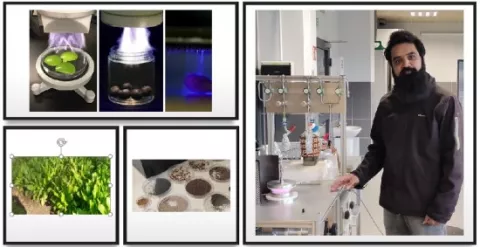
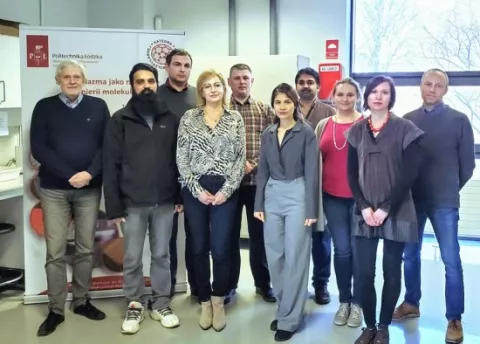
Electrical properties of cold plasma produced thin nanohybrid layers based on the carbon family
Together with M. Sc. Kaya Chakmak, our guest from the ERASMUS program (Akdeniz University, Turkey), we have investigated the conductivity of cold plasma-produced Sn-C and Co-C thin nanohybrid films. Based on macro-scale current-voltage characteristics and nano-scale measurements using conductive atomic force microscopy (CAFM), we have obtained results interesting for the potential application of the layers for water splitting into hydrogen and oxygen.
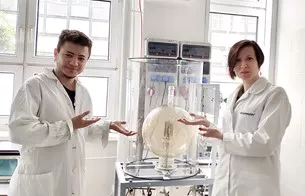
Plasma in the fight against textile sewage
To present the aim of the project Modern technology for the treatment and recycling of textile sewage implemented using plasma catalysts, the following questions should be answered: why does it concern the textile industry? and - how can cold plasma help achieve sustainable development goals?
The textile industry is deeply rooted in the history of Łódź, and the ubiquitous post-industrial architecture does not allow us to forget about textiles as the driving force that created and shaped this city. No one needs to be reminded that the anthem of Łódź is the song "Prząśniczka". The textile industry still strongly defines the economic structure of the region. According to the Association of Employers of the Clothing and Textile Industry (PIOT) statistics, over 100,000 people are employed in this industry in the Łódź region.
The project plans to use an innovative cold plasma technique to produce thin-layer catalysts deposited on a solid substrate with extensive geometry. This will create modern, active nanostructured materials covering the surface of the metal mesh. These materials will act as a heterogeneous catalyst in the ozonation process, increasing pollutant removal efficiency. The project will be implemented with the participation of Prof. Jacek Tyczkowski's research team members, who have many years of experience in cold plasma techniques. The developed technical solution (reactor with a plasma catalyst) will be tested on a larger scale in industrial conditions.
2021-06-10
Novel plasma-deposited photocatalysts for photoelectrochemical water-splitting
The partnership agreement between the Lodz University of Technology andthe Research Institute of Electronics (RIE) of Shizuoka University (Japan) resulted in a recent visit of PhD student of RIE Shizuoka University, Vytautas Kavaliunas, to our Department. MSc Kavaliunas participated in the short form of education aimed at taking measurements with the use of unique equipment of the Department of Molecular Engineering and obtaining materials for a Ph.D. thesis.
During his stay, Vytautas Kavaliunas together with the team members, established a method of TiO2 thinfilms preparation via cold plasma deposition (PECVD), as a top layer of novel multi-layer anode for the photoelectrochemical water-splitting process.
Electrochemical water decomposition with the use of solar irradiation is one of the most prospective ways of green hydrogen production, however, there is an urgent need for efficient photoactive catalyst development for this purpose.
Novel photocatalysts were studied using XPS, UP,S and UV-Vis spectroscopy techniques. Furthermore, photocatalytic properties of the complex anodes were examined via electrochemical LSV analysis of oxygen evolution reaction (OER) in the basic electrolyte solution. The study of the water splitting process with the use of obtained anodes will be continued both in the Department of Molecular Engineering and RIE, Shizuoka University.
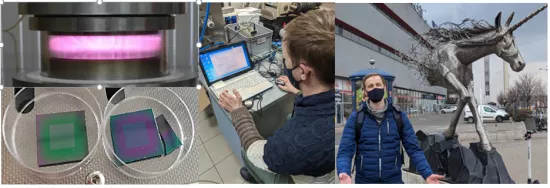
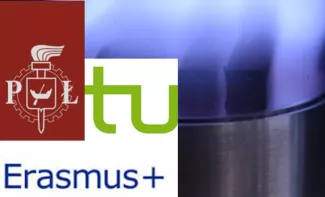
Recent advancesinf cold plasma applications in water splitting and the CO2 conversion
The new applications of cold plasma were investigated in our department within the following master projects (TUL-TU Dortmund University):
Conversion of CO2 in a cold plasma reactor - Arne Schemann (TU Dortmund University)
Water splitting to hydrogen over novel plasma deposited photocatalysts - Sheikh 'Ahmed' Mujaddadi (TU Dortmund University)
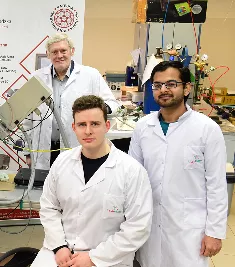
Thin layers deposited by cold plasma for electrochemical applications -a collaboration with the Jagiellonian University and AGH University of Science and Technology
Another new research topic was started during the recent stay of Maria Madej (PhD student from the Jagiellonian University in Cracow, Faculty of Chemistry, Department of Analytical Chemistry, Supervisors: Prof. Jolanta Kochana, Prof. Bogusław Baś) and Justyna Lipińska (PhD student from the AGH University of Science and Technology in Cracow, Faculty of Materials Science and Ceramics, Faculty of Analytical Chemistry, Supervisor: Prof. Bogusław Baś). Preliminary tests were conducted on new layers applied using cold plasma for applications in the construction of electrochemical sensors. Our research is focused on optimizing the layering parameters to achieve the best electrical conductivity while maintaining the high mechanical strength of the formed layers.
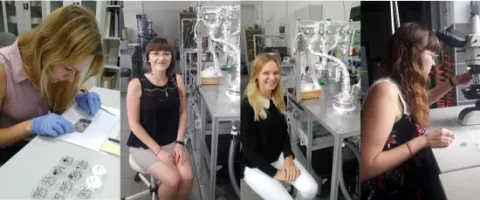
Cold plasma for a rational modification of MOFs –a collaboration with the Universidad Rey Juan Carlos (Madrid)
A neww research topicwasn started during the recent stay of Jesus Tapiador Cebrian in our labs in July 2019 Ph. D.D student from theUniversidadd Rey Juan Carlos, Chemical and Environmental Engineering Group, supervisors: Prof. Guillermo Calleja, D.r Gisela Orcajo). A cold plasma treatment has been applied for a rational modification of MOFs developed by the Spanish group. Metal-organic frameworks (MOFs) are advanced functional materials with very high porosity and well-defined structure. Our research is focused on optimizing their structural and functional characteristics for improved performance as catalysts (CO2 conversion, dye degradation) and also as hydrogen storage materials.

Jesus Tapiador Cebrian Plasma-jet Synthesis of MOF with plasma
2019-07-23

